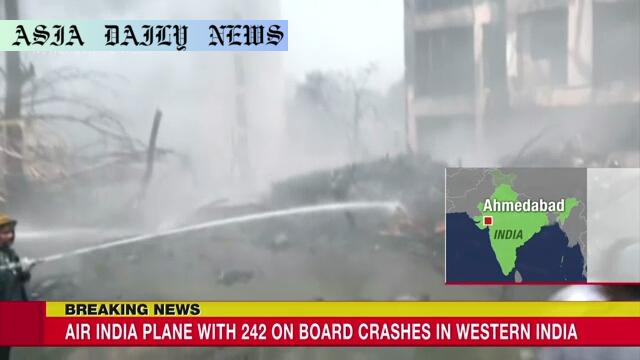Air India crash: Flight AI171 carrying 242 passengers met with an unfortunate accident in Ahmedabad.
- Flight AI171 carried 242 people, including passengers and crew.
- The crash occurred near Ahmedabad shortly after take-off.
- Emergency teams are assisting the injured, and investigations are ongoing.

Details of the Air India Crash Over Ahmedabad
In a tragic incident that has sent shockwaves globally, Air India flight AI171, departing from Ahmedabad to London Gatwick, met with an unfortunate accident shortly after take-off. At approximately 1:38 p.m., the Boeing 787-8 aircraft carrying 242 individuals, including passengers and crew, crashed near a residential area in Ahmedabad city, Gujarat, India. The devastating crash has prompted a swift response from authorities, emergency personnel, and Air India, as rescue operations continue to unfold at the site.
Among the 242 individuals onboard, there were 169 Indian nationals, 53 British nationals, seven Portuguese nationals, and one Canadian national. The airline announced that many injured passengers have already been rushed to nearby hospitals for immediate medical attention. The crash site showed heavy black smoke billowing up, as seen in live footage relayed by local news channels. Initial reports do not yet confirm the extent of the casualties, but the impact has caused significant devastation near residential locations.
Emergency Response and Investigation
Rescue and recovery operations have been expedited with the help of local authorities. Firefighters and paramedics were among the first responders, working tirelessly to manage the accident’s aftermath. The Government of India expressed condolences to those affected and ensured full-scale support for rescue operations. Air India also confirmed their full cooperation with investigative bodies seeking to uncover the crash’s causes. The airline issued a press release stating that all available resources are being mobilized to provide care and support to affected passengers and their families.
Although the exact cause of the accident remains unknown, aviation experts speculate potential technical malfunctions or adverse weather conditions. The airline has promised to share detailed updates as the investigation progresses and has set up emergency helplines for families searching for loved ones onboard Flight AI171.
Impacts and Future Implications
The crash of Flight AI171 has raised serious concerns regarding aviation safety procedures within the region. Experts are calling for a critical examination of existing systems and protocols to prevent future mishaps. As Air India and the Indian Civil Aviation Authority collaborate to piece together what went wrong, the global aviation community mourns yet another tragic accident in civil aviation. This event will likely prompt introspection on air travel safety and mechanisms to ensure the highest levels of precautionary measures.
As families await news of their loved ones, the incident serves as a grim reminder of the risks associated with air travel, underscoring the urgent need for technological and operational improvements to safeguard passengers worldwide.



Commentary
Understanding the Complexity of Aviation Accidents
The recent Air India crash involving flight AI171 is nothing short of a heart-wrenching tragedy, not only for the victims and their families but also for the global aviation community. While it is too early to speculate about the root cause of the accident, incidents like these often result in intensified scrutiny of standard operating procedures and safety features in the aviation sector. The crash has not only devastated lives but has also left experts grappling with questions about safety standards, technological systems, and emergency response measures in air travel.
Interconnected Impact on Global and Local Communities
An aviation disaster, particularly in a heavily populated area like Ahmedabad, puts an enormous strain on emergency services, medical facilities, and the surrounding community. The crash being so close to residential neighborhoods amplifies the risk of collateral damage, both in terms of destruction and casualties beyond passengers onboard. Moreover, diverse international involvement, with nationals from India, the United Kingdom, Portugal, and Canada, further demonstrates how deeply interconnected air travel is in today’s globalized world.
Moving Forward with Collective Responsibility
In the aftermath of such tragedies, grief is a natural reaction, but so is determination. Determination to find the root cause of the accident, to improve safety mechanisms, and to ensure that incidents like flight AI171’s crash become a rare anomaly rather than a recurring headline. Beyond the aviation industry, public policymakers, engineers, and experts must collaborate on advancing smart systems including weather prediction, aircraft maintenance protocols, and real-time monitoring during flights. In mourning lives lost, we must also aim to create a future with fewer tragedies to mourn.